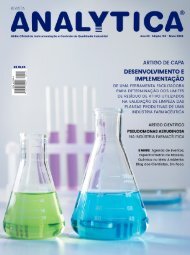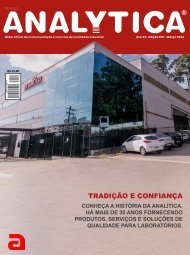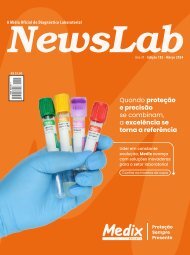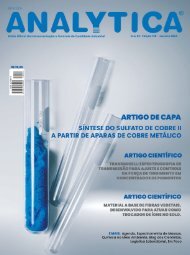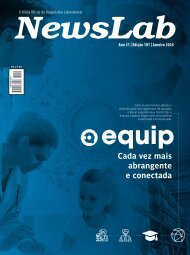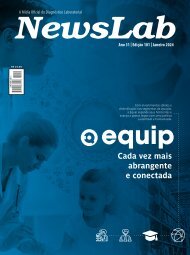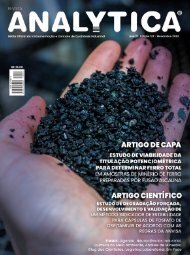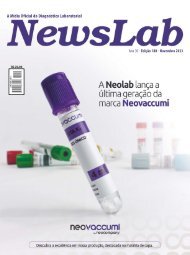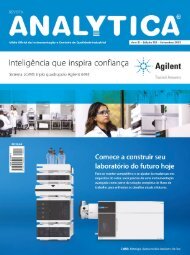Create successful ePaper yourself
Turn your PDF publications into a flip-book with our unique Google optimized e-Paper software.
VIROLOGIA<br />
RISCO DO SARS-COV-2 EM ANIMAIS,<br />
NOVAS MUTAÇÕES E INOVAÇÕES TERAPÊUTICAS<br />
RISK OF SARS-COV-2 IN ANIMALS, NEW MUTATIONS AND THERAPEUTICS INNOVATIONS<br />
Por: Dra. Rachel Siqueira de Queiroz Simões<br />
* Fundação Oswaldo Cruz.<br />
Resumo<br />
Ao longo dos estudos de evolução filogenética e monitoramento<br />
das cepas circulantes do SARS-CoV-2 comprovou-se que o vírus<br />
pode ser classificado como uma antropozoonose ou zoonose<br />
reversa. Em media, 70% das doenças zoonóticas são de origem<br />
infecciosa emergente responsável por fatores determinantes<br />
causando o desequilibrio ambiental frente ao comércio illegal de<br />
práticas ilícitas como a caça aos animais silvestres que ameaça a<br />
integridade do ecossistema. A adaptação do vírus proveniente do<br />
hospedeiro natural para o hospedeiro intermediário alcançando<br />
o homem pode ser explicado pelo fenômeno Spillover. Elevada<br />
taxa de recombinação genômica propiciou altas taxas de<br />
mutações com possíveis alterações, deleções ou substituições<br />
de aminoácidos atingindo diversas espécies animais algumas<br />
mais susceptíveis à infecção viral e outras consideradas menos<br />
susceptíveis pela não detecção do RNA viral em amostras<br />
clínicas. O objetivo do artigo é traçar um paralelo entre os<br />
riscos de infecção do novo coronavírus nas diferentes espécies<br />
de animais domésticos e silvestres, descrever as principais<br />
mutações documentadas por modelagem computacional por<br />
meio dos softwares PyMOL e PDBePISA e nomear os anticorpos<br />
terapêuticos e fármacos antivirais recentemente investigados no<br />
tratamento da COVID-19.<br />
Palavras-Chave: Animais, anticorpos monoclonais,<br />
coronavírus, fármacos antivirais e mutações.<br />
Abstract<br />
Throughout the studies of phylogenetic evolution and<br />
monitoring of circulating strains of SARS-CoV-2, it was proved<br />
that the virus can be classified as anthropozoonosis or reverse<br />
zoonosis. On average, 70% of zoonotic diseases are emerging<br />
infectious origin responsible for determining factors causing<br />
environmental imbalance in the face of illegal trade in illicit<br />
practices such as a hunting wild animals that threatens the<br />
integrity of the ecosystem. The adaptation of the virus from<br />
the natural host to the intermediate host reaching man can<br />
be explained by the phenomenon called Spillover. High rate<br />
of genomic recombination provided high rates of mutations<br />
with possible changes, deletions or substitutions of amino<br />
acids reaching several animal species, some more susceptible<br />
to viral infection and others considered less susceptible due<br />
to the non-detection of viral RNA in clinical samples. The<br />
objective of this paper is to design a parallel between the<br />
risks of infection of the new coronavirus in different species of<br />
domestic and wild animals, to describe the main mutations<br />
documented by computer modeling through PyMOL e<br />
PDBePISA software and to name the therapeutic antibodies<br />
and antiviral drugs recently investigated in the treatment of<br />
COVID-19.<br />
Key Words: Animals, monoclonal antibodies, coronavirus,<br />
antiviral drugs and mutations.<br />
0 108<br />
<strong>Revista</strong> NewsLab <strong>Edição</strong> <strong>166</strong> | Julho 2021




